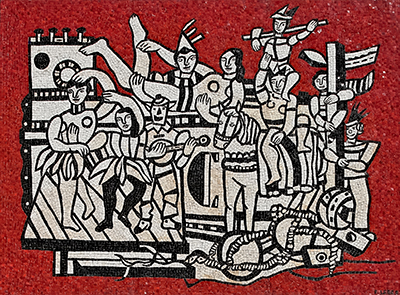Grand Parade with Red Background is an oil painting that was done by Fernand Leger in 1911 and is currently part of a private collection. It is a clear representation of his art which was based on the balanced contrast of colours and shapes developed on a monumental scale.
Leger Found real inspiration in 1907 when he saw a retrospective exhibition of the work of Cezanne in Paris. He realised that Cezanne used to colour in quite a unique way, instead of employing it in service of his pictures, he made the pictures in service of colour. Colour is one of the great protagonists in the works of Leger and one of the causes of the undoubted sight of his paintings. In this particular piece, Leger uses two-dimensional figures and synthetic cubism to achieve all kinds of Illusionists variations.
The colours used are pure, uniform and clearly delimited, without blending or blurring. Both buildings and various architectural constructions are merged as if adapting to each other by removing all kinds of naturalness. For Leger, sharp contrasts between flat colours and constructed shapes gave a dynamic effect to his compositions. In the Grand Parade with Red Background, the shapes are outlined in black. Colour is also used in a frank and isolated manner on an unprepared canvas in a grey tone. Simple volumes are rendered thanks to light and shadow effects. Leger, through such art, led analytical cubism to its logical conclusion, total abstraction. Leger would experiment across his career and try out different styles as well as mediums. His book illustrations proved successful and he also turned his hand to sculpture in later life as well.
The plans are arranged in a balanced way and the compositions are organised by well-defined areas. With this work, he tried to capture industrialisation and how the cities changed with the invention of machines. He could interact with the world in an emotionally detached and purely objective level, and this was a rare gift. It allowed him to take pleasure in the aesthetics of objects without the baggage of sentimental attachment. Leger's compositions show a better synthesis of the figures in space, which are linked and in a circular movement giving a feeling of dynamism and joy. He was an optimist, and to him, if colour was brought to life, it could have therapeutic values. His large compositions show his desire to paint a modern Arcadia, where a man would achieve harmony with nature despite modernity. There are clearly elements to this painting which remind us of Soviet-era posters, capturing the will of the people and encouraging them all to stick together and work hard for the benefit of the Communist state.




